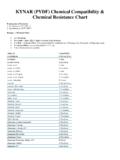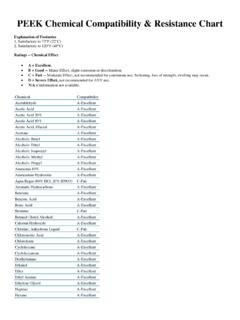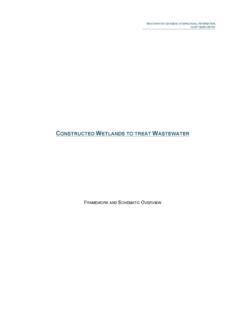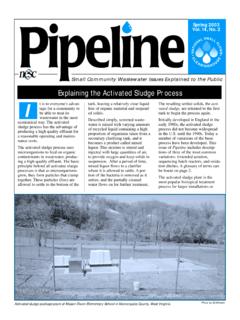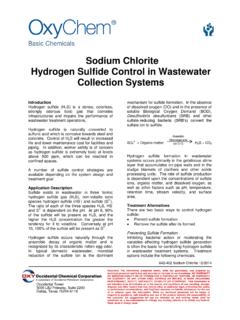Transcription of CYANIDE WASTES Significance
1 1 of 17 Advanced Sensor Technologies, Inc. 603 North Poplar Street Orange, CA 92868-1011 Phone: (716) 978-2837 Fax: (714) 978-6339 CYANIDE WASTESS ignificanceCyanides are toxic to aquatic life, interfere with normal biological processes of naturalpurification in streams, present a hazard to agricultural uses of water, and are a menace topublic water supplies and bathing. Cyanides exert a toxic action on living organisms, animals,and human beings by reducing or eliminating the utilization of oxygen in a manner similar toasphyxiation. The action at the toxic level is both rapid and the microorganisms in a surface water responsible for proper oxygen balance lose theirefficiency or are destroyed, oxygen depletion of the stream ensues. Fish in such a streamstand the chance of being killed either directly by the CYANIDE content or indirectly by thedestruction of the organisms upon which they feed.
2 The toxic threshold level for some speciesof fish is reported to be to ppm CYANIDE as (CN) radical. This toxicity increases asthe temperature increases and as the dissolved oxygen decreases. The toxic action isapparently related to photosynthesis, for it has been demonstrated that fish in the absence ofsunlight can thrive in water containing 1000 ppm and other animals are likewise endangered when using a stream polluted withcyanides. Lethal doses to animal and man amount to only 4 mg/lb. of body weight. A streamused for bathing or a domestic water supply should not contain even a trace of WASTES definitely impair the biological processes of waste treatment plants,although these processes do reduce the CYANIDE concentration. The amount of reduction ofcyanide concentration in these various processes has never been determined, and therefore itis not possible to establish a maximum allowable limit in the raw sewage entering the plant.
3 Amaximum of 1 ppm in the raw sewage has been suggested. Most CYANIDE waste treatmentplants discharging into the local collection system are designed to reduce the free CYANIDE toat least 2 ppm (CN).In addition to the cyanides present in metal-finishing WASTES , there may be copper and zincions, which are also toxic to fish and other aquatic life. The toxic threshold level for somespecies of fish is reported to be to ppm copper and CYANIDE compounds are widely used in industry, five processes are responsible for mostof the CYANIDE WASTES causing stream pollution and presenting problems in waste treatmentplant operation. These processes are: metal plating, case hardening of steel, neutralizing ofacid "pickle scum," refining of gold and silver ores, scrubbing of stack gases from blast andproducer gas of 17 Advanced Sensor Technologies, Inc. 603 North Poplar Street Orange, CA 92868-1011 Phone: (716) 978-2837 Fax: (714) 978-6339 Metal Plating: The greatest source of CYANIDE -bearing waste is found in the metal-finishingindustry, whose electroplating plants are distributed throughout the country.
4 Most of thecyanide WASTES are the rinse waters, spillage, and drippings from the plating solutions ofcadmium, copper, silver, gold, and zinc. These plating solutions will vary in concentrations ofalkali and "free" CYANIDE (sodium or potassium), but the various metal baths are similar inconcentration. The following shows the contents of a solution for a brass-plating operation:Copper cyanide4 oz/gal30000 ppmZinc cyanide1 1/4 oz/gal9200 ppmSodium cyanide7 1/2 oz/gal57000 ppmSodium carbonate4 oz/gal30000 ppmTotal CN = 39000 ppmCase Hardening of Steel (Nitriding): The process of heat treating steel by CYANIDE consistsof' immersing the steel part at a predetermined temperature in a molten bath of a mixture ofsodium CYANIDE , barium chloride, sodium chloride, potassium chloride, and strontiumcarbonate. When the part has been held for the proper time in this molted bath, it is withdrawnand quenched in a continuous flow of water, The discharge from such a bath may be expectedto run as high as 50 to 100 ppm of free of Acid Pickle Scum: In the pickling of steel sheet for the removal of mill scale,the metal is usually dipped in dilute sulfuric and hydrochloric acid.
5 As the steel leaves thispickling bath, a coating called pickle smut, consisting of materials not soluble in the acid - ironcarbide, silicon, silicon carbide, copper, and copper sulfides remains on the surface. Inaddition, ferrous sulfate and ferrous chloride are formed and cling to the surface. If the sheet isthen air dried or neutralized with caustic, the ferrous iron is converted to ferric iron, whichcovers the pickle smut and forms a coating difficult to remove and destructive to the finish ofthe sheet. It can be removed by agitation in a solution of sodium CYANIDE ( oz/gal) andsodium hydroxide ( oz/gal). The resulting waste from this solution contains free CYANIDE inconcentrations between 200 and 1000 of Gold and Silver Ores: The present method of gold recovery from ore is theMcArthur-Forrest process, first patented in 1887, which is based on the solubility of gold in acyanide solution.
6 The gold is ultimately precipitated from this solution by zinc dust. Thechemical reactions are as follows:4Au + 8 KCN + O2 + 2H2O = 4 KAu (CN)2 + 4 KOH (7-15)The precipitation of gold by zinc dust is represented by:2 KAu (CN)2 + Zn2Au + K2Zn (CN)2(7-16)3 of 17 Advanced Sensor Technologies, Inc. 603 North Poplar Street Orange, CA 92868-1011 Phone: (716) 978-2837 Fax: (714) 978-6339 The potassium-zinc- CYANIDE solution remaining after the gold is precipitated in Eq. 7-16 is thewaste to be , gold can be dissolved in a sodium CYANIDE solution:4Au + 8 NaCN + O2 + 2H2O = 4 NaAu (CN)2 + 4 NaOH(7-15a)The gold is then precipitated with zinc dust as follows:4 NaAu (CN)2 + 2Zn = 4 Au + 2Na2Zn (CN)4(7-16a)The recovery of silver from its ore is similar. The reaction is:2Ag + 4 NaCN + O + H2O 2 NaAg(CN)2 + 2 NaOH(7-17)The silver is then precipitated by zinc dust or aluminum powder. The remaining cyanidesolution must then be treated for the destruction of cyanides before of Stack Gases: CYANIDE is a by-product of the manufacture of carbides.
7 Thecyanide gets into the flue gas and appears in the wastewater from the flue gas scrubber. Thiswastewater must then be treated for the destruction of the of these WASTES described above are so toxic to man and animal alike that even inremote areas such as Nevada, where there are many gold and silver processing plants, thestate Department of health requires that the CYANIDE be completely destroyed, even whenthese WASTES are stored in protected of the TreatmentThere are two types of CYANIDE WASTES : free CYANIDE (NaCN or KCN), and combined orcomplex CYANIDE (Na2 Au(CN)2).Destruction of Free CYANIDE to Cyanate: When chlorine in its various forms (represented asC12 below) is applied to a free CYANIDE such as sodium CYANIDE , oxidation takes place,producing cyanogen chloride:NaCN + Cl2 CNCl + NaCl (7-18)This reaction is practically instantaneous, and is independent of pH. Cyanogen chloride isalso a toxic waste , and, since it volatilizes readily (similar to NCl3), its formation is to beavoided.
8 Cyanogen chloride can be converted to a more stable compound with proper pHcontrol. In the presence of alkali, represented by NaOH, it decomposes to cyanate at pH as follows:CNCl + 2 NaOH - NaCNO + NaCI + H2O (7-19)At a controlled pH of to , it takes 10 to 30 minutes for 100 percent completion of thisreaction - that is to say, the conversion of free CYANIDE to cyanate with chlorine. As the pH4 of 17 Advanced Sensor Technologies, Inc. 603 North Poplar Street Orange, CA 92868-1011 Phone: (716) 978-2837 Fax: (714) 978-6339increases, the reaction time diminishes. At pH 10 to 11, the time is on the order of 5 to 7minutes. If the pH drops to as low as , cyanogen chloride will begin to form. This is to theoretical requirements for destruction of free cyanides to cyanates are as parts of chlorine for each part of free CYANIDE as CN; parts of caustic as, NaOH parts of hydrated lime (Ca(OH)2) per part of chlorine actual practice, it requires more chlorine since other chlorine-consuming compounds areusually the waste is of rather high alkalinity, and so the alkali requirements average out lessthan one part - usually to parts of alkali per part of chlorine.
9 If ammonia is present inthe waste , causing formation of chlorarnines, it is not economically desirable to chlorinatebeyond the breakpoint to a free chlorine residual, since chloramines will react to destroy thefree CYANIDE . It simply takes a little longer time. For chloramine treatment, allow an additional15 minutes. The pH control is critical and is to be measured after the flow-through or the batch system of treatment is acceptable when it is necessaryonly to destroy cyanides to cyanates. The flow-through system can be more economical sinceit is possible to control the reaction between chlorine and CYANIDE to form cyanate before thereaction between chlorine and cyanate can begin. This economical advantage may not be ofprimary consideration when it is imperative always to destroy the free CYANIDE of Cyanates to Carbon and nitrogen : Cyanates are several hundred-fold lesstoxic than are the cyanides, but there -are times when it is mandatory to destroy them.
10 Thecyanates present as the end product in the destruction of the cyanides at pH to are notreadily decomposed by water or the excess alkali present in the treated waste unless freechlorine is present. The cyanates in the presence of chlorine slowly hydrolyze to formammonium carbonate and sodium carbonate:"3Cl2 + 4H2O + 2 NaCNO 3Cl2 + (NH4)2 CO3 + Na2 CO3 (7-20)Chlorine does not take part chemically in this reaction, but does aid in completing thereaction within one to one and a half-hours. It is thought that chlorine acts as a catalyst in The chlorine in Eq. 7-20 must be free available to complete this reaction. After thehydrolysis of Eq. 7-20 takes place, the chlorine and caustic rapidly oxidize the ammoniumcarbonate to nitrogen gas, and the carbonates are converted to bicarbonates as follows:3Cl2 + 6 NaOH + (NH4)2 CO3 + Na2CO32 NaHCO3 + N2 + 6 NaCI + 6H2O(7-21)As part of this reaction, but not shown, small amounts of inert nitrous oxide (N2O) andvolatile nitrogen trichloride (NCl3) are also of 17 Advanced Sensor Technologies, Inc.

